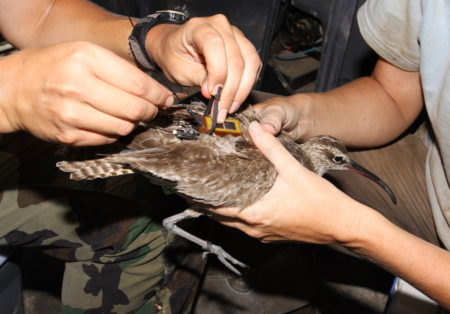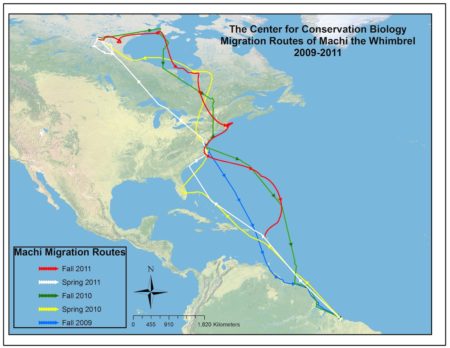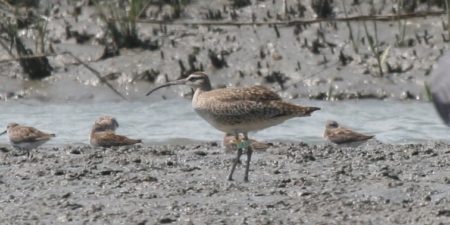Our new video, “Caribbean Shorebirds Under Fire,” is the fourth in our series on the plight of our shorebirds, which are facing a drastic decline in numbers. This video highlights the need for well-regulated, sustainable hunting on several Caribbean islands where it is a traditional way of life. It can be disturbing, but we are looking for the way forward. We owe it to our beautiful shorebirds. We hope you will watch, share, and help us find solutions. Content Warning: Birds that have been shot.
This video is also available in French and Spanish.
Hunting has a strong tradition in the Caribbean, with shorebird hunting being especially prevalent on the islands of Guadeloupe, Martinique, and Barbados.
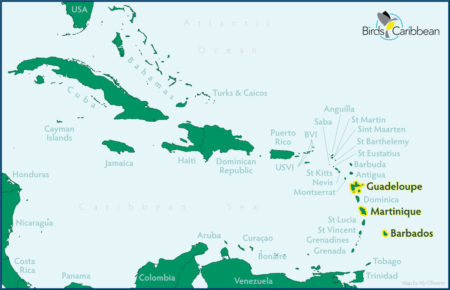
For example, the history of shorebirds harvest on Barbados dates back to the to the mid-seventeenth century, in the early colonial period when Barbados was settled. As shorebirds visit the region on their fall migration and during winter, they use Caribbean wetlands to rest and refuel, take refuge from adverse weather, and as a winter home.
Some hunters – for example in Barbados – provide such habitats, managing small wetlands (“shooting swamps”) to attract shorebirds. The habitat is vitally important for tired and hungry migrant shorebirds but its use comes at a cost to the birds, as many then become the targets of sport hunting. On the islands of Guadeloupe and Martinique, however, wetlands are more abundant and the opportunities for hunting shorebirds are much broader. Targeted species include Lesser Yellowlegs, Pectoral Sandpiper, Stilt Sandpiper, Short-billed Dowitcher, Greater Yellowlegs, Whimbrel, and American Golden-Plover. We know that these and other shorebird populations in the Atlantic Flyway and the entire planet have drastically declined in numbers (50-90%) over the past 3 decades.
The Sad Story of Machi and Goshen
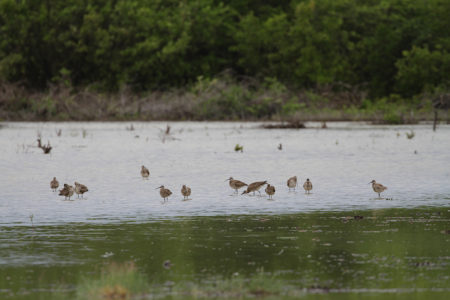
Machi and Goshen were two Whimbrels fitted with satellite tracking tags by scientists at the Center for Conservation Biology. We learned that these two sturdy birds took detours around the violent tropical storms of 2011 and made their way further south through the eastern Caribbean. Machi, in particular, had taken some extraordinary trips in his lifetime, clocking many thousands of miles since he was first tagged in 2009.
But in 2011 – just ten years ago now – a sad fate awaited them. News broke that Machi had been shot by hunters at a swamp in Guadeloupe. The news of Goshen’s death, in the same area, swiftly followed. They had weathered the storms, only to end their lives at the barrel of a gun.
A Flood of Letters, and a Change in Guadeloupe
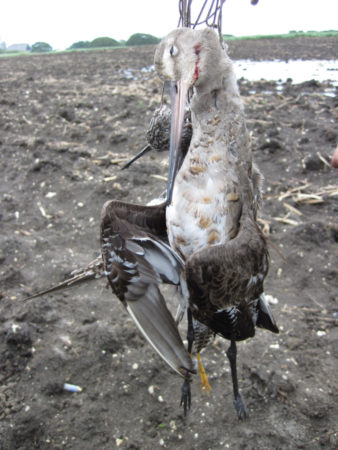
At the time, hunting in Guadeloupe and nearby Martinique had few or no regulations on which species could be shot, how many could be shot, or the number of days hunting was allowed. With the spotlight on the issue of shorebird hunting, BirdsCaribbean (then the SCSCB – Society for the Conservation and Study of Caribbean Birds) and partners organized a letter writing campaign. Letters went out in the hundreds – to decision makers in the environmental departments of the French Government, as well as to other key institutions and international organizations. Please, make the harvest of shorebirds more sustainable, the letters urged.
After this campaign, some positive progress was made to Guadeloupe’s hunting regulations. In 2012 and 2013 Red Knot and Solitary Sandpipers were removed from the list of shorebirds that could be hunted. Daily bag limits (20 shorebirds per hunter per day) were introduced and regulations set specific days when hunting was not permitted, giving shorebirds some respite.
On Martinique Red Knots were also removed from the hunting list. However, no bag limits or ‘days off’ were set. It was also clear that on both islands, many declining and threatened shorebird species were still being shot by hunters in numbers that might not be sustainable.
We Must Celebrate the Successes!
So…let’s look at the positives.
Each year in Guadeloupe and Martinique hunting regulations are set by decree (separately for each island). In 2021, besides previous restrictions, shooting of Whimbrels on Guadeloupe was not permitted and the hunting of Hudsonian Godwits was set at two per day. On Martinique shorebird hunting was still allowed for 206 days of the year, with no ‘days off’ from hunting. Although some bag limits were set on Martinique, most were deemed by conservationists to be too high to be sustainable.
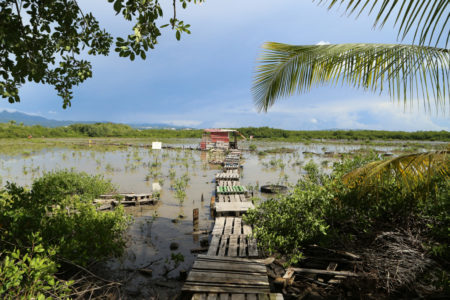
In the fall of 2021, an alliance of nature protection groups* came together to oppose the 2021-22 decrees in both Guadeloupe and Martinique. They requested the suspension of hunting of the Hudsonian Godwit on Guadeloupe—a species of conservation concern and rare on Guadeloupe. On Martinique, they requested the suspension of hunting of 10 shorebirds and four songbirds, all with poor conservation status on the island. Many BirdsCaribbean members and partners sent in emails (over 1,000) opposing the hunting decree.
Ruling on these requests, a judge banned the hunting of five shorebirds on Martinique (Whimbrel, Hudsonian Godwit, Short-billed Dowitcher, American Golden Plover, and Black-bellied Plover). Martinique also set a bag limit of 20 Lesser Yellowlegs per day per hunter in 2020/21, the first time a restriction has been put in place for this species! On Guadeloupe the hunting of Hudsonian Godwits was also stopped.
It was not an easy task, but the efforts and passion of non-governmental organizations, their members and supporters deserves a huge pat on the back. This was a “win” for shorebirds!
Some Positive Changes to Hunting in Barbados
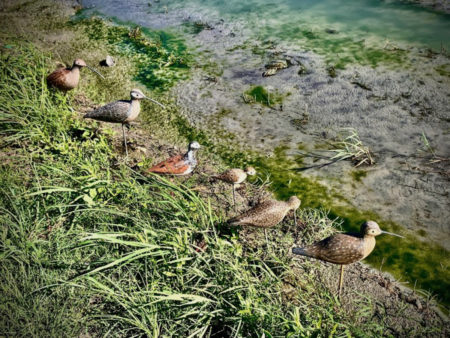
Barbados is a small, low-lying island on the far eastern edge of the Lesser Antilles. Because of its rather far-flung position, many shorebirds land on the island to avoid severe storms. Hunting in the early years when birds were abundant provided an opportunistic harvest of shorebirds for food and sport. Over time, opportunistic harvest transitioned to managing land to make it more attractive to shorebirds.
With few remaining natural wetlands, the shooting swamps developed by hunters on the island provide excellent habitats for shorebirds and many non-target waterbird species, both resident and migrants. They will likely rely on these managed wetlands even more in the future as severe storms and drought increase with climate change.
The good news is that shorebird hunting in Barbados has been in decline since the 1990s. A number of shooting swamps have closed, with only five active today. By the late 2000s harvesting had declined from roughly 20– 30,000 to approximately 10,000 annually. Why is this? Well, this is partly because younger people have lost interest in hunting and the cost of hunting is rising. Also, the Barbados Wildfowlers Association, representing a number of shooting swamp owners, decided to self-regulate. The Association recommended voluntary measures to reduce daily and total harvest using suggested daily and seasonal bag limits.
Refuge from the Storm for Shorebirds on Barbados?
On a small island, land and water are precious commodities. Abandoned swamps get used for other purposes, such as agriculture, reducing wetland habitats for birds. So, to maintain such habitats, shorebird refuges came into being. In 2008, the first shorebird refuge was created: Woodbourne Shorebird Refuge as a haven for shorebirds. The greater awareness and appreciation of the value of these wetlands by some members of the hunting community has also contributed to preserving some non-active shooting swamps for shorebirds. They may not be large, but they are some of the best places to observe a wonderful diversity of shorebirds and waterbirds on the island.

What Can We Do?
Here are two facts that are indisputable: Firstly, shorebirds are declining at an unprecedented rate. Taking the example of the Lesser Yellowlegs, its numbers have fallen by 60-70 percent since the 1970s!
Secondly, we believe that we can make a difference if conservationists and hunters work together to build a well-managed, sustainable hunting program. Historically, hunters have played an important role in conservation; for example, the nonprofit Ducks Unlimited has worked with landowners and federal and state agencies to conserve, restore, and manage millions of hectares of wetland habitats for ducks, other wildlife, and people. The dialogue among all stakeholders must continue. We all know that regulations and monitoring are essential, going forward, or the steady decline in shorebirds, most of which are migratory, will continue with disastrous results. So, enforcement of the laws that already exist, and development of future ones, is vital.
It is all doable!
Barbados Needs More Wetlands – Hunters Could Play a Role
As we have noted, Barbados does not have large natural wetlands. What they do have needs to be protected and maintained. Just as in Canada and the United States today, hunters can, and often do, play a vital role in conserving habitat. Now, will hunting become less popular as a pastime in Barbados? If so, the shooting swamps hunters created could become shorebird refuges. If a network of such wetland refuges, including former shooting swamps, could be gradually developed, how marvelous that would be for the shorebirds, for other wildlife – and for the people of Barbados. They could even be the basis for an expansion of eco-tourism, including birding trails for locals and visitors to enjoy.
Let’s Work Together
On Guadeloupe and Martinique, much work needs to be done to bring a sense of balance to the situation. Working together, conservation groups, the island governments and the hunting community can foster a less confrontational state of affairs. The work must continue, because we are all aware that this year’s ruling does not guarantee the same restrictions will apply to the 2022/23 shorebird hunting regulations.

Our shorebirds are under pressure like never before, and we must stop their precipitous decline. Shorebird hunting can be sustainable, with shorebirds thriving for everyone to enjoy. Please take a look at our latest video on shorebird hunting. We welcome your comments, suggestions and support, as we seek solutions. Please share and “like” our shorebird posts on social media.
We promise we will stay focused on this important issue for our precious shorebirds and will update you on any new developments as we go along.
It’s for the shorebirds of the Caribbean!
We thank Environment and Climate Change Canada, the US Fish and Wildlife Service, the Atlantic Flyways Shorebird Initiative, US Forest Service International Programs, film maker Esther Figueroa, talented photographers and videographers, and our partners, members, and donors for your generous support to create this video (fourth in a series!) and carry out Caribbean shorebird and waterbird conservation initiatives.
Please support out shorebird conservation work – thank you!
* Organizations asking for changes to hunting rules: AMAZONA, Association pour la Protection des Animaux Sauvages, Association pour l’Étude et la protection des Vertébrés et végétaux des petites Antilles, L’Association Francophone des Soigneurs Animaliers, Le Carouge, and Ligue pour la Protection des Oiseaux
To learn more about Caribbean shorebirds and our work to conserve them, check out the following articles and links therein:

